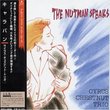| All Artists: Brian Ferneyhough, Ensemble Recherche Title: Brian Ferneyhough: Flurries; String Trio; In nomine a 3; Streichtrio; Incipits Members Wishing: 0 Total Copies: 0 Label: Stradivarius Original Release Date: 1/1/2005 Re-Release Date: 6/14/2005 Album Type: Import Genre: Classical Styles: Chamber Music, Historical Periods, Classical (c.1770-1830) Number of Discs: 1 SwapaCD Credits: 1 UPC: 8011570336941 |
Search - Brian Ferneyhough, Ensemble Recherche :: Brian Ferneyhough: Flurries; String Trio; In nomine a 3; Streichtrio; Incipits
 | Brian Ferneyhough, Ensemble Recherche Brian Ferneyhough: Flurries; String Trio; In nomine a 3; Streichtrio; Incipits Genre: Classical
|
CD DetailsSimilar CDs |
CD ReviewsWonderful chamber stuff all the way scarecrow | Chicago, Illinois United States | 07/01/2005 (5 out of 5 stars) "Ferneyhough's music speaks within a framework of traditional genre for the most part, It never strays too far from known venues as the String Quartet and the Chamber setting.
His music still carries the torch of modernity's agendas some believe to either have fallen off the ends of the globe for its persisting "alienating" experiences (that it doesn't engage the predictable cash box vigorously)or to have that "heroic" dimension Adorno loved so much for its "aesthetic in exile" persists in its resistance to the normal flow of the commons. The "String Trio" here is a persistent example still engaging the modern sensibility for its exposed clarity as it did for Schoenberg and Webern, also (W.Zimmermann,Pascal Dusapin,and J. Kalitzke have endeavored trios as new parts of the literature.) Here Ferneyhough's Trio seems relatively more facile(underogatorily) in its surface complexity more tutti statements than his other moments of the string repertoire,as the 'Second and Third String Quartets'. I suppose anyone's musical language does transform itself,out of itself(not as Kafka's bug let's hope) even if one's aesthetic as Ferneyhoughs at times seems to have been hard-boiled and overdetermined. His opera experience with "Shadowtime"(after the life of Walter Benjamin) seems to have been a "cleansing" experience, with the direct engagement of the human voice and the theatre.And it seems felt in all the pieces here ones approching that opera in sketches, (There is simply more human intervention in an opera than the cloistered private experience of writings string quartets.) But here the "String Trio" exhibits a little more rarefied beauty, clean threadbare lines unencumbered without inter-referential,'filtered' pitch configurations within a 'context' here the richness then seems to have more linear telescoping triggers,always looking downstream for resolution. Likewise "Flurries" another interesting chamber setting after poet A/R Ammons,who had appealed to Ferneyhough's penchant for unstructured shapes is as fodder to be shaped into decipherable dodecaphonic materials within the work.And the exposed linearity is what excites Ferneyhough, for he has written the most interesting chamber music. The therapeutic and ethical dimension of Ammons poetry finds its way into the compositional process here.The work takes its time an elegant use of space beginning as a string duet,then the clarinet with piano punctuation, like a miniature cadenza.Microintervals as well,in the Clarinet tossed the works consitution off center skewed into Ammons therapeutic. Then the Horn's turn to reveal itself with flighty Piccolo. Much like unencumbered dialogue,(non-Socratic) the Horn is quite arrogant,like it refuses to be part of the work ethically it belongs somewhere else. The strings respond with their own tortuered language of glissandi and double-stopped punctuations.(Complexity in-and-of-itself seems to be a requisite sight for subjectivity to relish in its own exclusion from the mainstream,from interactive communication with other humans) the private place, like Lacan's "objet petit a" Again the musical results have an abundance of interest, each timbre finely interwoven, Piccolo,Clarinet,Horn, Violin and Cello.All as soloists independent of each other yet mindful of the space it inhabits, or will inhabit in the future;difficult blends at times and combinations to foster and to co-inhabit the frame. "Incipits" features the Viola as soloist, a neglected instrument;Here beginning with wonderful tremoli on woodblocks with pizz viola and legato, again establishing a space.This piece is more understated.It works quite well within the quasi-concerti language.There is more uncertainty however which makes the work compelling,more opaque-ness here like the work doesn't know where it wants to go meandering wistfully into highly complex statements 'sotto voce' habitations but all again reiterate their materials together,not much independence is sought here.This is like Ferneyhough is painting now with larger brushes then the pencil-thin impeccable ones of previous days.There are also simply "mists" of timbres should we call them "noises", more background canvas, as in the Contrabass and Percussion that follows without freedom the main lines. The Viola admirably goes on with its lifeworld miniature fragments not really leading anyone anywheres.But it is a beautiful instrument with the plucked moments,alternating with legato atonal lines almost arbitrary.Barbara Mauer is wonderful as Violist here,great to hear someone besides the Arditti cadre perform this music. There is also a one minute"String Trio" included here written for a friend A.Richards, a mere mist of gesture. Ensemble recherche are a committed bunch to this music and always bring a clarity and a search for an expressive center." |

 Track Listings (5) - Disc #1
Track Listings (5) - Disc #1
